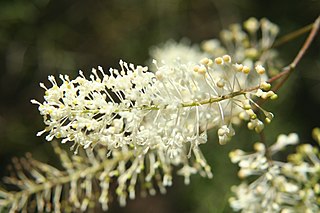
Grevillea leptopoda is a flowering plant originally found in Western Australia, mostly near Geraldton.

Grevillea aquifolium is a shrubby or scrambling plant endemic to South Australia and Victoria. Common names include holly grevillea, prickly grevillea or variable prickly grevillea. In occurs naturally in woodland, open forest and heathland.
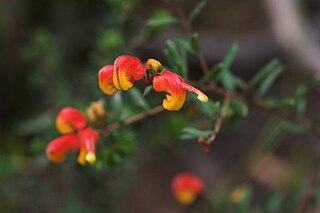
The Australian flowering shrub Grevillea alpina has several common names, including mountain grevillea, alpine grevillea, and cat's claws. It is not limited to alpine environments, and in fact is less common at high elevation than low. The species is variable in appearance, with five general forms described: small-flowered, Grampians, Northern Victorian, Goldfields, and Southern Hills forms. It is found in dry forests and woodlands across Victoria and into southern New South Wales. Some forms of the plant are low to the ground, and some become a spreading shrub. The flowers come in many colours, from white to green to shades of red and pink, or a pattern of several colours. The curled flowers are 1 to 3 centimetres in length. It is attractive to nectar-feeding insects and birds.

Grevillea 'Superb' is a widely grown grevillea cultivar bred by Merv Hodge in Queensland. It is a hybrid of a white-flowered Grevillea banksii, from Queensland, and the Western Australian plant G. bipinnatifida.

Grevillea 'Robyn Gordon' is a grevillea cultivar which has been planted widely in Australia and other countries.
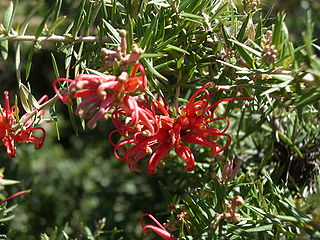
Grevillea juniperina, commonly known as juniper- or juniper-leaf grevillea or prickly spider-flower, is a plant of the family Proteaceae native to eastern New South Wales and south-eastern Queensland in Australia. Scottish botanist Robert Brown described the species in 1810, and seven subspecies are recognised. One subspecies, G. j. juniperina, is restricted to Western Sydney and environs and is threatened by loss of habitat and housing development.
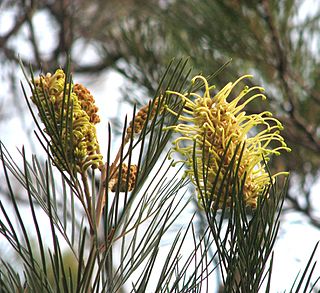
Grevillea whiteana, also known as Mundubbera grevillea, is an erect shrub or tree which is endemic to Queensland.
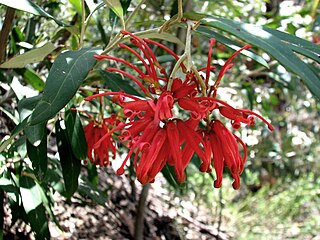
Grevillea victoriae, also known as royal grevillea or mountain grevillea, is a shrub which is endemic to south-eastern New South Wales and mountainous parts of Victoria in Australia.

Grevillea treueriana, also known as Mount Finke grevillea, is a shrub that is endemic to Mount Finke in South Australia. It is listed as vulnerable under the EPBC Act.

Grevillea 'Peaches and Cream' is new and much sought-after grevillea cultivar which has been recently released in Australia.
Grevillea 'Fire Sprite' is a grevillea cultivar. It is a cross between G. longistyla and G. venusta. First developed in 1996, it was registered with the Australian Cultivar Registration Authority (ACRA) in 2007. It has a shrubby habit, reaching 3 m (10 ft) high and 5 m (15 ft) wide.

Grevillea stenomera, commonly known as lace net grevillea, is a shrub in the family Proteaceae. It is endemic to Western Australia, occurring between Kalbarri and Tamala.
Grevillea pteridifolia is a species of Grevillea native to Australia. Common names include silky grevillea, Darwin silky oak, ferny-leaved silky oak, fern-leaved grevillea, golden grevillea, golden tree and golden parrot tree. It occurs in Western Australia, Northern Territory, and Queensland.
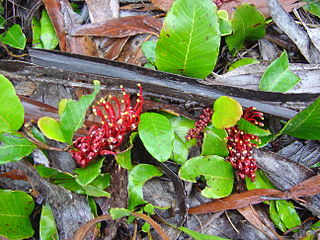
Grevillea laurifolia, commonly known as the laurel-leaf grevillea, is a spreading prostrate shrub native to eastern Australia.
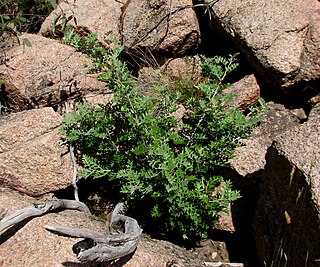
Grevillea willisii is a shrub species which is endemic to the eastern highlands of Victoria, in Australia. Common names include Omeo Grevillea and Rock Grevillea.

Grevillea parvula , commonly known as Genoa grevillea, is a species of the plant genus Grevillea. It is native to the states of Victoria and New South Wales in Australia.
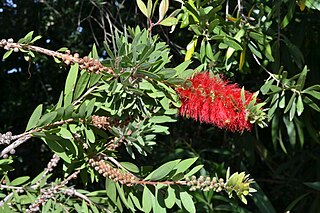
Melaleuca citrina, commonly known as common red, crimson or lemon bottlebrush, is a plant in the myrtle family, Myrtaceae and is endemic to New South Wales and Victoria in Australia. It is a hardy and adaptable species, common in its natural habitat. It is widely cultivated, not only in Australia, often as a species of Callistemon. It was one of the first Australian plants to be grown outside the country, having been taken to England in 1770 by Joseph Banks. Its showy red flower spikes, present over most of the year in an ideal situation, account for its popularity.
William Lancashire Cane (1911–1987) was an Australian plantsman who introduced many new native plant species, forms and hybrids into cultivation.
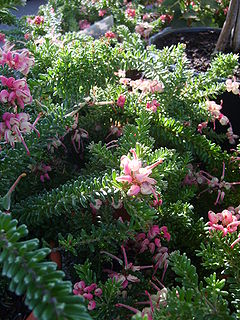
Grevillea lanigera 'Mt Tamboritha' is a cultivar of the genus Grevillea, planted widely in Australia and other countries for its ornamental foliage and flowers. It is the most popular form of Grevillea lanigera in cultivation. It is also known by the names 'Mt Tamboritha form', 'Compacta', 'Prostrate', 'Prostrate Form' or the misnomer 'Mt Tambourine'.
















